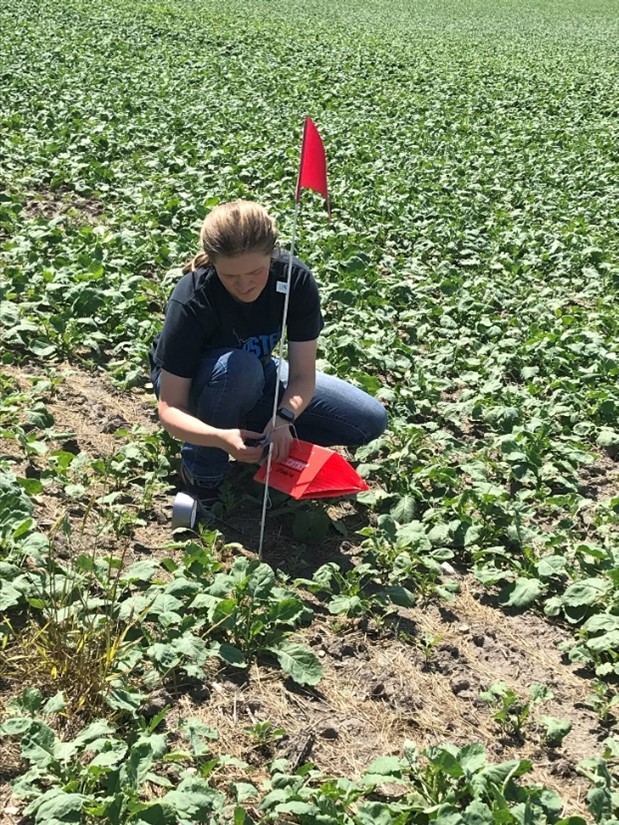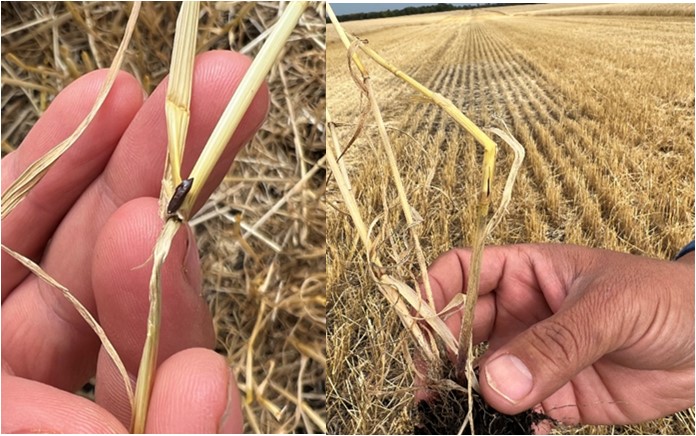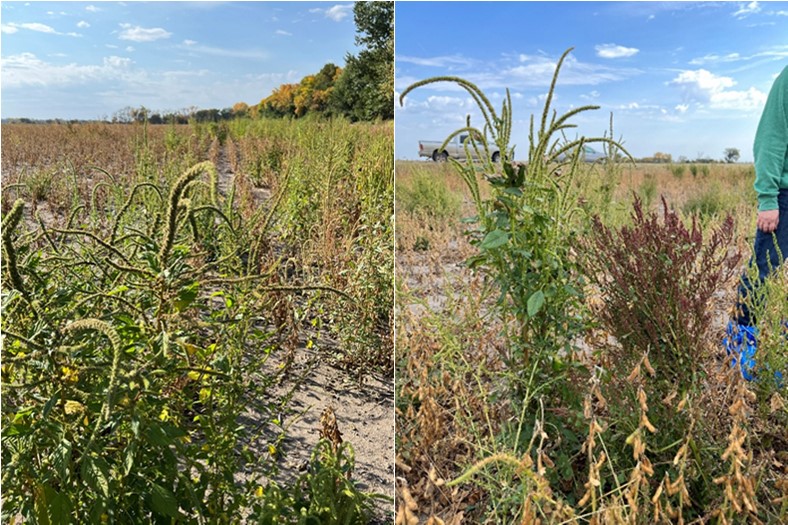IPM Trapping and Scouting: The NE IPM survey team consisted of a scout and a trapper. During the crop growing season, the scout conducted weekly surveys from each of the nine (Grand Forks, Pembina, Cavalier, Walsh, Ramsey, Nelson, Benson, Rolette and Towner) counties for insects and diseases of crops such as wheat, barley, soybean and sunflower. The trapper conducted pheromone trapping (for insect pests such as wheat midge, wheat army worm and black cut worm in wheat; swede midge, canola flower midge, diamondback moth and bertha army worm in canola; banded sunflower moth, sunflower moth and Arthuri moth in sunflower (Figure 1). Results of scouting and trapping were tracked from various regions of ND and updated weekly on the IPM website: https://www.ndsu.edu/agriculture/ag-hub/ag-topics/crop-production/diseases-insects-and-weeds/integrated-pest-management.
Figure 1. IPM trapper setting up a pheromone trap for canola Swede midge
Hessian Fly in Wheat: Hessian fly (Mayetiola destructor (Say)) was observed infesting several spring wheat fields in Cavalier County. Hessian fly is one of the most serious insect pests of wheat in the United States. Infestations are sporadic in North Dakota with outbreaks being reported in 1991, 2003 and 2015 (Glogoza 2004, Knodel 2015). Hessian fly belongs to the midge family (Cecidomyiidae) of which another important insect pest orange blossom wheat midge belongs to. Hessian fly larvae cause damage by injecting salivary toxins into the plant cells while feeding which interferes with the growth of the plant thereby weakening or killing the plant. Adult Hessian flies are small (1/8th inch) mosquito like with smoky gray wings. In the spring, females lay eggs on the upper surfaces of wheat leaves. Upon hatching, the larvae move to the base of the leaf and remain feeding beneath the leaf sheath.
Damage
The stage of the wheat plant and the degree of infestation determines the severity of hessian fly damage. Larval feeding at an early seedling stage might kill the plant. However, infestation in later stages of the crop might result in severe stunting with bluish colored leaves or weakening of the stem which usually breaks just above the first or second node (Figure 2) leading to lodging.
The infested fields in Cavalier County had stems broken with 1-2 flaxseed-like maggots (Figure 2). The fields appeared to have a significant infestation, almost 5% of heads were lodged or not harvestable. Northwest Minnesota also reported high pressures of Hessian fly near the Beltrami area and the least amount of pressure in the fields closest to Crookston (Source: Dr. Jochum Wiersma, UMN).
Management
Insecticides are not recommended for Hessian fly problems considering the sporadic nature of the pest and the difficulty in optimizing the timing of adult emergence. Best management practices include:
- Controlling volunteer wheat in late summer
2. Using resistant varieties
Figure 2: Hessian fly larva in flaxseed stage. Hessian fly feeding damage with wheat stem bent above the first node.
Waterhemp and Palmer are spreading in NE North Dakota:
Waterhemp and Palmer are the two most important pigweed species posing a challenge to crop production in ND. Both are tough weeds to control as they have developed resistance to nearly every herbicide mode of action that is being used in crop production. These weeds share some similar characteristics that makes them troublesome and challenging:
1)They are dioecious which means male and female plants are separate
2) Produce extreme amounts of seed (1-5 million seeds per plant)
3) Emerge throughout the crop season until August
In 2022, waterhemp had been identified in a field (field pea) near Milton in Cavalier County. Although waterhemp has been reported in this county before (around 2015) in the Vang area, it has not spread and appeared to be contained. The distribution of waterhemp plants throughout the field and in headland area shows the infestation appeared to have been spread by the combine. The source of seed was not identified.
Figure 3: Palmer amaranth; palmer (left) and waterhemp (right) plants next to each other in a soybean field in Traill County
In addition, palmer amaranth was also identified in a soybean field along with waterhemp in Traill County. Palmer has been spreading in ND since its first report in 2018. Farmers are encouraged to pay attention to the weed species and their management practices to help prevent the spread of these troublesome weeds. Farmers are strictly advised to seek the help of county Extension agents and weed officers in case of a palmer or waterhemp suspicion. It is very important to correctly identify the weed to make sound management decisions.



